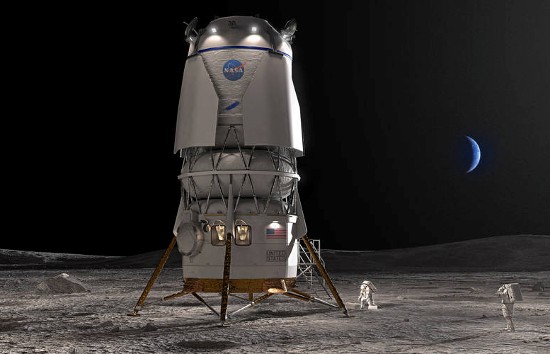NASA is not putting all its eggs in one basket with today’s announcement of a second lunar lander for the Artemis Program. Joining the SpaceX Human Landing System (HLS) will be Blue Moon, built by Blue Origin.
In today’s announcement, NASA administrator, Bill Nelson stated that the Agency needs more than one option for the Artemis Program. Nelson describes the current efforts as representing “a golden age of human spaceflight” stimulated by NASA’s partnerships with companies like SpaceX and Blue Origin, as well its international partners, the European Space Agency (ESA), the Japanese agency, JAXA, the Canadian Space Agency and others. Nelson noted that “together, we are making an investment in the infrastructure that will pave the way to land the first astronauts on Mars.”
Lisa Watson-Morgan, Manager of NASA’s Human Landing System Program describes the value of having options. “Having two distinct lunar lander designs, with different approaches to how they meet NASA’s mission needs, provides more robustness and ensures a regular cadence of Moon landings. This competitive approach drives innovation, brings down costs, and invests in commercial capabilities to grow the business opportunities that can serve other customers and foster a lunar economy.”
Where Artemis IV will use a modified SpaceX Starship, the HLS, as its lunar lander, Artemis V will use Blue Moon. Watson-Morgan’s claim that NASA’s methodology will bring down costs needs to be proven. Artemis V, slated for 2029, has a budgeted cost of $3.4 billion. It’s a fixed-cost contract which is an improvement over those previously negotiated by NASA with its commercial partners. Take, for example, the Boeing Space Launch System (SLS) negotiated as “cost-plus” and running billions of dollars over the original amount and years late in delivery.
Current Timelines for Artemis
It started with Artemis I in November 2022 with the first test run of the SLS and Orion space capsule. The mission lasted 25 days going beyond the Moon. It was uncrewed. and tested the launch system and space capsule.
Artemis II is next up on a schedule that bears no resemblance to the dogged pace of the Apollo Program in the 1960s. With NASA no longer in a space race with the Soviet Union, the timelines are stretched in getting back to the Moon.
If there is a competitor to NASA in a future Moon and Mars race, it is China, but the latter’s program is still in catch-up mode.
Artemis II will launch in November 2024 with a crew of four onboard the Orion for a ten-day flight around the Moon and back to Earth. It won’t attempt to enter lunar orbit. Instead, it will be a long fly-around.
Artemis III is planned for November 2025. It will demonstrate the Starship HLS which will launch separately from Earth. The two will rendezvous in lunar orbit with two crewmembers transferring to the HLS for the first return mission to the Moon’s surface since the last Apollo Program flight in 1972. The Moon visit will last a little over six days before rejoining Orion for the return flight to Earth.
Artemis IV is scheduled for September 2028, almost three years later. Lots of new hardware will be featured in this mission including an upgrade to the SLS, and the addition of the Lunar Gateway which will be delivered to the Moon by SpaceX. The Gateway will become a lunar space station and serve as a habitat for future missions. Its role in Artemis IV will be to serve as the rendezvous point for Orion and the SpaceX HLS. Two crew members will transfer to the latter from the Gateway and two will remain in orbit to give the new lunar space station a complete shakedown. HLS will descend to the lunar surface on a multi-day mission, then return to Orion for the flight back to Earth.
Then comes the Artemis V mission sometime in 2029. This time Orion will dock with the Gateway where 2 of the crew will transfer to Blue Moon. This lunar lander stands over 15 meters (50 feet) tall. It can handle a crew of up to 4 for lunar descent. The current plans, however, call for a lunar surface mission with 2 on board. How it gets to lunar orbit is still unknown.
The status of the New Glenn launch system to take Blue Moon to lunar orbit and rendezvous with the Gateway is only one of several deliverables needed for all of these missions to work.
Before that, the SpaceX HLS has to work. Currently, HLS is based on the Starship with its mated heavy launch booster. The two had to be blown up after technical malfunctions just a few weeks ago. This first flight reached an altitude of 39 kilometres (24 miles), a far cry from getting to orbit let alone making it to the Moon.
The Gateway has to be delivered and assembled through several missions while in lunar orbit.
And finally, Blue Moon has to be built and work to specification. Artemis V is not called a demonstration mission but it will be for the lunar lander.
The entire Artemis Program is counting on succeeding as a public-private partnership. This is NASA’s model for the “golden age” of space exploration. It is dependent on all of these disparate parts and players to come together.
At the same time, the Agency has to be cognizant of the enormous cost of Artemis as a staging exercise for the ultimate goal, a crewed mission to Mars by the mid-2030s.
If Artemis’ cost overruns impact NASA’s scientific programs, will this return to the Moon be worth what gets dropped from the Agency’s exploration of the Solar System and the search for life elsewhere in The Universe?
Let’s hope Artemis unfolds as planned providing us all with a new reason to look up at the Moon where humans will once again tread on its surface.









